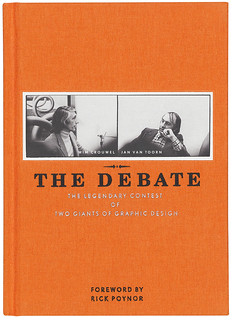The Debate the Legendary Contest of Two Giants of Graphic Design Book Review
The Debate: The Legendary Contest of 2 Giants of Graphic Design, designed past Part of CC (Mentum-Lien Chen and Chris Vermaas)
Top: Crouwel'due south 1965 calendar for printer Erven Eastward. van de Geer (left) and Van Toorn'due south 1972-73 agenda for printer Mart. Spruijt.

In an early exchange, Crouwel spells out his position: 'I believe that every bit a designer I must never stand between the message and its recipient.' Van Toorn rebuts this idea: 'I do not believe that a designer can adopt […] the position of neutral intermediary. The acts you perform take place through you, and you lot are a subjective link. But you lot deny this subjectivity, meaning you view your occupation as a purely neutral i.'
The debate in its transcribed and translated state is remarkably short and just occupies 23 out of a total of 176 pages of this, the first English language-language version in book form. The discussion covers three master areas: the social and professional person role of the designer; the value of grids and typographic tradition; and the function of the graphic designer when designing for museums and fine art galleries.
Both men speak from positions of confidence. The exchanges are more often than not courteous and respectful of each other'southward viewpoints. Simply on the question of the use of grids – a fundamental of Crouwel's exercise – does the discussion accomplish boiling bespeak. Van Toorn vehemently states: 'You impose your design on others and level everything. Yous were at the forefront, and at present our country is inundated by waves of trademarks and house styles and everything looks the same.' He continues: 'To me, your approach is not relevant, and in my view yous should not propagate it equally the just possible solution for a number of communication issues, considering it's not true. What your approach does is basically confirm existing patterns. This is non serving communication – information technology is conditioning human behaviour.' For his part, Crouwel dismisses subjectivity in design, and singles out Van Toorn's Spruijt calendar for a mild put-down: 'as pretentious as a slice of so-chosen proficient blueprint, or as a clean piece of design.'
Reading this debate 40 years afterwards it happened, it is hard to see what all the fuss was well-nigh. This is considering the polarities that both men represent no longer exist to anything like the degree they one time did, and the notion of there being merely one position for the designer to adopt is redundant. Graphic design today is characterised by what Rick Poynor calls its 'pluralism' – a condition he defines every bit a 'willingness to accept that there are enough of ways of doing design, or anything else, and many equally valid outcomes.'
Nor does the transcribed argue offer the sort of clarity and precision of argument that might be expected from these ii highly intelligent and articulate men. It is unclear whether this is the fault of the translation, or something to do with the hothouse nature of a public debate where members of the audience shouted angry comments ('That is bullshit!' 'That's a prevarication!' 'Crap!' 'Nonsense!').
In truth both men are meliorate served by the many quotes from their writings used by Frederike Huygen in her essay 'The Argue in Context'. With her customary sharp eye and deep knowledge of Dutch pattern, Huygen uses well called extracts from the published texts of the ii protagonists and, in and then doing, allows them to make their arguments with more than force and greater pointedness.
Regardless, both men are giants of the profession and individualistic practitioners worthy of our gratitude and admiration. They have added greatly to the storehouse of design philosophy, and that fact lonely makes this book an indispensable addition to the literature of graphic design.
Adrian Shaughnessy designer, writer, Unit Editions, London
Commencement published in Eye no. 90 vol. 23, 2015
Source: https://www.eyemagazine.com/review/article/a-dutch-battle-that-still-rattles
0 Response to "The Debate the Legendary Contest of Two Giants of Graphic Design Book Review"
Post a Comment